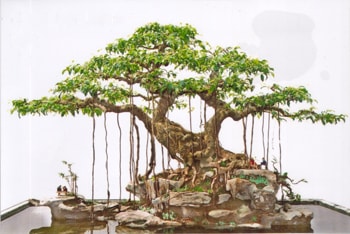Awakening the potential of ornamental plants
(Baonghean) - Nghe An is a land with potential for ornamental plants (AVR). With 83 km of coastline, 6 river mouths and creeks with abundant marine resources: 207 aquatic species, if you know how to utilize shrimp, crab, clams, snails, mussels... to make AVR, you will create many interesting AVR products. Nghe An is rich in rocks with continuous limestone areas stretching from Hoang Mai to Hong Linh, with red rocks, blue rocks, white rocks, curb rocks, slate rocks, cowhide rocks, leopard skin rocks, elephant skin rocks... if you are "skillful or collect" you will also get many attractive AVR products. Nghe An driftwood is rich, all of which are rare species, ironwood is abundant in Quy Hop, Tan Ky, Ky Son, Do Luong... Do Luong driftwood participates in the AVR Festival in Ho Chi Minh City and the 1000-year Thang Long - Hanoi exhibition, and is very popular. There are many birds in Nghe An. According to the survey, there are currently 335 species, many of which are precious ornamental birds, such as: peacocks, pheasants, penguins, realgar, thrushes, thrushes, starlings, starlings, parrots, nightingales, red-whiskered bulbuls, turtledoves, partridges...

Illustration photo
Speaking of the flora, Nghe An is extremely rich. According to the Department of Agriculture and Rural Development of Nghe An, forest land and forestry land account for 71% of the natural area. The Western Nghe An Biosphere Reserve covers over 1 million hectares and has been recognized by UNESCO as a world biosphere reserve with biodiversity. Initially, 1,193 plant species belonging to 163 families, 537 genera, and 342 animal species were discovered. In the barren hills, although covered with pine, cajuput, eucalyptus... but under the canopy of trees there are many beautiful ornamental trees such as: sanh, si, da, de, sim, mua, me, moc, rong rang, ruoi, muc, son tue, lau que, kim tangerine, truc, say, sat, egg, vo ngua, lau, mun chan chim, mai da... Then the border plants create a beautiful campus with many types extending from the hills, through the narrow plains to the longitudinal and transverse beaches to the brackish water coastal areas such as thousand star tree, string of pearls, che man, cun rum... this type is easy to trim to create attractive bonsai, ornamental animals.
In the gardens of Nghe An people, there are many "environmental" plants such as Acanthopanax, Dracaena, Water Banana, Dieffenbachia... There are many types of plants that are both ornamental and medicinal such as Dracaena, Thuja, Starfruit, Pomegranate, Magnolia, Wallflower, Aloe Vera, Cymbidium, Mimosa pudica, Chrysanthemum... Plants that are both ornamental and "functional foods", if we know how to plant and choose the right soil, are very useful such as: Erythrina, Green Tea, Green Orchid, Polyscias fruticosa, Indian laurel, Indian laurel, Fig, Lemon, Starfruit, Tangerine... These are native plants that have lived with people for a long time, serving people, but people have not really cared for and cherished them to make people and the landscape more beautiful, more harmonious, more friendly; not to mention many types of imported plants that have been around for a long time, some of which have become ancient, typically coniferous trees such as pine, Casuarina, which are very easy to beautify.
Recently, the Nghe An SVC Association surveyed 461 trees of 43 species ranging in age from 100 to 1,000 years old, most of which are associated with historical and cultural relics. If preserved, these will not only be "treasures" of Nghe An but also of the nation. Nghe An currently has 5 SVC craft villages recognized by the Provincial People's Committee. These are the craft villages: Hong Phu (Quynh Hong), Nghi Lien, Nghi Kim, Nghi An, Hung Dong (Vinh City). However, the economic efficiency of the craft villages is not really high, because the facilities are still fragmented and there is no systematic investment in technology. But anyway, these are breakthroughs in the business path.
The SVC Association has been consulting with Party committees, authorities, the Fatherland Front, the Department of Agriculture and Rural Development, and the Department of Culture at all levels to preserve and promote the diversity of SVC resources in order to build a movement and bring this valuable source of ornamental plants into service of life.
Ho Duc Thinh (Quynh Luu Student Association)






